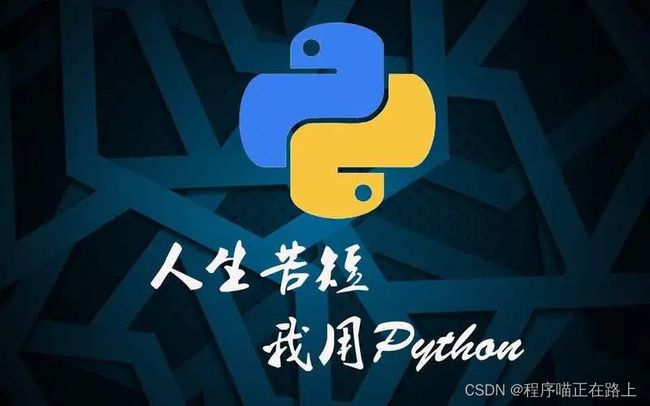【Python】详解面向对象(下篇)
越努力,越幸运,这里是博主程序喵
欢迎关注点赞收藏留言
本文由 程序喵正在路上 原创,CSDN首发!
系列专栏:Python从入门到入坟
首发时间:2022年7月13日
✅ 如果觉得博主的文章还不错的话,希望小伙伴们三连支持一下哦
阅读指南
- 面向对象 —— 继承
- 单继承
- 多继承
- 子类重写父类同名方法和属性
- `_mro_` 魔法方法
- 子类调用父类的同名属性和方法
- 多层继承
- super()调用父类方法
- 私有属性
- 1. 定义私有属性和方法
- 2. 修改私有属性值
- 继承总结
- ⚡面向对象 —— 其他
- 面向对象三大特性
- 多态
- 类属性和实例属性
- 类方法和静态方法
- 总结
面向对象 —— 继承
生活中的继承,一般指的是子女继承父辈的财产
- 经典类和旧式类
不由任意内置类型派生出的类,称之为经典类
class 类名:
代码
......
- 新式类
class 类名(object):
代码
Python 面向对象的继承指的是多个类之间的所属关系,即子类默认继承父类的所有属性和方法,具体如下
# 父类A
class A(object):
def __init__(self):
self.num = 1
def info_print(self):
print(self.num)
# 子类B
class B(A):
pass
result = B()
result.info_print() # 1
在 Python 中,所有类默认继承 object 类,object 类是顶级类或基类;其他子类叫做派生类
单继承
故事主线:一个煎饼果子老师傅,在煎饼果子界摸爬滚打多年,研发了一套精湛的摊煎饼果子的技术。师傅要把这套技术传授给他唯一的最得意的徒弟。
分析:徒弟是不是要继承师父的所有技术?
# 1. 师父类
class Master(object):
def __init__(self):
self.kongfu = '[古法煎饼果子配方]'
def make_cake(self):
print(f'运用{self.kongfu}制作煎饼果子')
# 2. 徒弟类
class Prentice(Master):
pass
# 3. 创建对象daqiu
daqiu = Prentice()
# 4. 对象访问实例属性和方法
print(daqiu.kongfu)
daqiu.make_cake()
多继承
故事推进:daqiu是个爱学习的好孩子,想学习更多的煎饼果子技术,于是,在百度搜索到培训班,想报班学习煎饼果子技术
所谓多继承的意思就是一个类同时继承了多个父类
class Master(object):
def __init__(self):
self.kongfu = '[古法煎饼果子配方]'
def make_cake(self):
print(f'运用{self.kongfu}制作煎饼果子')
# 创建学校类
class School(object):
def __init__(self):
self.kongfu = '[新式煎饼果子配方]'
def make_cake(self):
print(f'运用{self.kongfu}制作煎饼果子')
class Prentice(School, Master):
pass
daqiu = Prentice()
print(daqiu.kongfu)
daqiu.make_cake()
注意:当一个类有多个父类的时候,默认使用第一个父类的同名属性和方法
子类重写父类同名方法和属性
故事:daqiu掌握了师父和培训的技术后,自己潜心钻研出自己的独门配方的一套全新的煎饼果子技术
class Master(object):
def __init__(self):
self.kongfu = '[古法煎饼果子配方]'
def make_cake(self):
print(f'运用{self.kongfu}制作煎饼果子')
class School(object):
def __init__(self):
self.kongfu = '[新式煎饼果子配方]'
def make_cake(self):
print(f'运用{self.kongfu}制作煎饼果子')
# 独创配方
class Prentice(School, Master):
def __init__(self):
self.kongfu = '[独创煎饼果子配方]'
def make_cake(self):
print(f'运用{self.kongfu}制作煎饼果子')
daqiu = Prentice()
print(daqiu.kongfu)
daqiu.make_cake()
结论:如果子类和父类拥有同名属性和方法,子类创建对象调用属性和方法的时候,调用到的是子类里面的同名属性和方法
_mro_ 魔法方法
看起来继承关系很复杂,但是通过__mro__魔法方法我们可以直接看到调用顺序
class Master(object):
def __init__(self):
self.kongfu = '[古法煎饼果子配方]'
def make_cake(self):
print(f'运用{self.kongfu}制作煎饼果子')
class School(object):
def __init__(self):
self.kongfu = '[新式煎饼果子配方]'
def make_cake(self):
print(f'运用{self.kongfu}制作煎饼果子')
# 独创配方
class Prentice(School, Master):
def __init__(self):
self.kongfu = '[独创煎饼果子配方]'
def make_cake(self):
print(f'运用{self.kongfu}制作煎饼果子')
daqiu = Prentice()
print(daqiu.kongfu)
daqiu.make_cake()
print(Prentice.__mro__)
子类调用父类的同名属性和方法
故事:很多顾客都希望也能迟到古法和新式的技术制作的煎饼果子
class Master(object):
def __init__(self):
self.kongfu = '[古法煎饼果子配方]'
def make_cake(self):
print(f'运用{self.kongfu}制作煎饼果子')
class School(object):
def __init__(self):
self.kongfu = '[新式煎饼果子配方]'
def make_cake(self):
print(f'运用{self.kongfu}制作煎饼果子')
class Prentice(School, Master):
def __init__(self):
self.kongfu = '[独创煎饼果子配方]'
def make_cake(self):
# 如果是先调用了父类的属性和方法,父类属性会覆盖子类属性,故在调用属性前,先调用自己子类的初始化
self.__init__()
print(f'运用{self.kongfu}制作煎饼果子')
# 调用父类方法,但是为保证调用到的也是父类的属性,必须在调用方法前调用父类的初始化
def make_master_cake(self):
Master.__init__(self)
Master.make_cake(self)
def make_school_cake(self):
School.__init__(self)
School.make_cake(self)
daqiu = Prentice()
print(daqiu.kongfu)
daqiu.make_cake()
daqiu.make_master_cake()
daqiu.make_school_cake()
多层继承
故事:N年后,daqiu老了,想要把所有技术继承给自己的徒弟
步骤:
- 创建类Tusun,用这个类创建对象
- 用这个对象调用父类的属性或方法看能否成功
class Master(object):
def __init__(self):
self.kongfu = '[古法煎饼果子配方]'
def make_cake(self):
print(f'运用{self.kongfu}制作煎饼果子')
class School(object):
def __init__(self):
self.kongfu = '[新式煎饼果子配方]'
def make_cake(self):
print(f'运用{self.kongfu}制作煎饼果子')
class Prentice(School, Master):
def __init__(self):
self.kongfu = '[独创煎饼果子配方]'
def make_cake(self):
self.__init__()
print(f'运用{self.kongfu}制作煎饼果子')
def make_master_cake(self):
Master.__init__(self)
Master.make_cake(self)
def make_school_cake(self):
School.__init__(self)
School.make_cake(self)
# 徒孙类
class Tusun(Prentice):
pass
xiaoqiu = Tusun()
xiaoqiu.make_cake()
xiaoqiu.make_school_cake()
xiaoqiu.make_master_cake()
super()调用父类方法
class Master(object):
def __init__(self):
self.kongfu = '[古法煎饼果子配方]'
def make_cake(self):
print(f'运用{self.kongfu}制作煎饼果子')
# 继承Master类
class School(Master):
def __init__(self):
self.kongfu = '[新式煎饼果子配方]'
def make_cake(self):
print(f'运用{self.kongfu}制作煎饼果子')
# 方法1
# super(School, self)._init_()
# super(School, self).make_cake()
# 方法2
super().__init__()
super().make_cake()
# 继承School类
class Prentice(School):
def __init__(self):
self.kongfu = '[独创煎饼果子配方]'
def make_cake(self):
self.__init__()
print(f'运用{self.kongfu}制作煎饼果子')
# 子类调用父类的同名属性和方法:把父类的同名属性和方法再次封装
def make_master_cake(self):
Master.__init__(self)
Master.make_cake(self)
def make_school_cake(self):
School.__init__(self)
School.make_cake(self)
# 一次性调用父类的同名属性和方法
def make_old_cake(self):
# 方法一:代码冗余;父类类名如果变化,这里代码需要频繁修改
# Master._init_(self)
# Master.make_cake(self)
# School._init_(self)
# School.make_cake(self)
# 方法二:super()
# 方法2.1 super(当前类名, self).函数()
# super(Prentice, self).__init__()
# super(Prentice, self).make_cake()
# 方法2.2 super().函数()
super().__init__()
super().make_cake()
daqiu = Prentice()
daqiu.make_old_cake()
注意:使用
super()可以自动查找父类,调用顺序遵循_mro_类属性的顺序,比较适合单继承使用
私有属性
1. 定义私有属性和方法
在 Python 中,可以为实例属性和方法设置私有权限,即设置某个实例属性或实例方法不继承给子类
故事:daqiu把技术传承给徒弟的同时,不想把自己的钱(2000000个亿)继承给徒弟,这个时候就要为钱这个实例属性设置私有权限
设置私有权限的方法:在属性名和方法名前面加上两个下划线_
class Master(object):
def __init__(self):
self.kongfu = '[古法煎饼果子配方]'
def make_cake(self):
print(f'运用{self.kongfu}制作煎饼果子')
class School(object):
def __init__(self):
self.kongfu = '[新式煎饼果子配方]'
def make_cake(self):
print(f'运用{self.kongfu}制作煎饼果子')
class Prentice(School, Master):
def __init__(self):
self.kongfu = '[独创煎饼果子配方]'
# 定义私有属性
self.__money = 2000000
# 定义私有方法
def __info_print(self):
print(self.kongfu)
print(self._money)
def make_cake(self):
self.__init__()
print(f'运用{self.kongfu}制作煎饼果子')
def make_master_cake(self):
Master.__init__(self)
Master.make_cake(self)
def make_school_cake(self):
School.__init__(self)
School.make_cake(self)
# 徒孙类
class Tusun(Prentice):
pass
daqiu = Prentice()
# 对象不能访问私有属性和私有方法
print(daqiu.__money)
daqiu.__info_print()
xiaoqiu = Tusun()
# 子类无法继承父类的私有属性和私有方法
# print(xiaoqiu.__money)
# xiaoqiu.__info_print()
注意:私有属性和私有方法只能在类里面访问和修改
2. 修改私有属性值
在 Python 中,一般定义函数名 get_xx 用来获取属性,定义 set_xx 用来修改私有属性值
class Master(object):
def __init__(self):
self.kongfu = '[古法煎饼果子配方]'
def make_cake(self):
print(f'运用{self.kongfu}制作煎饼果子')
class School(object):
def __init__(self):
self.kongfu = '[新式煎饼果子配方]'
def make_cake(self):
print(f'运用{self.kongfu}制作煎饼果子')
class Prentice(School, Master):
def __init__(self):
self.kongfu = '[独创煎饼果子配方]'
# 定义私有属性
self.__money = 2000000
# 获取私有属性
def get_money(self):
return self.__money
# 修改私有属性
def set_money(self):
self.__money = 500
def __info_print(self):
print(self.kongfu)
print(self._money)
def make_cake(self):
self.__init__()
print(f'运用{self.kongfu}制作煎饼果子')
def make_master_cake(self):
Master.__init__(self)
Master.make_cake(self)
def make_school_cake(self):
School.__init__(self)
School.make_cake(self)
# 徒孙类
class Tusun(Prentice):
pass
xiaoqiu = Tusun()
# 调用get_money函数获取私有属性money的值
print(xiaoqiu.get_money())
# 调用set_money函数修改私有属性money的值
xiaoqiu.set_money()
print(xiaoqiu.get_money())
继承总结
- 继承的特点
◦ 子类默认拥有父类的所有属性和方法
◦ 子类重写父类同名属性和方法
◦ 子类调用父类同名属性和方法 - super() 方法快速调用父类方法
- 私有权限
◦ 不能继承给子类的属性和方法需要添加私有权限
◦ 语法
class 类名():
# 私有属性
__属性名 = 值
# 私有方法
def __函数名(self):
代码
⚡面向对象 —— 其他
面向对象三大特性
- 封装
◦ 将属性和方法书写到类的里面的操作即为封装
◦ 封装可以为属性和方法添加私有权限 - 继承
◦ 子类默认继承父类的所有属性和方法
◦ 子类可以重写父类属性和方法 - 多态
◦ 传入不同的对象,产生不同的结果
多态
了解多态
多态指的是一类事物有多种形态(一个抽象类有多个子类,因而多态的概念依赖于继承)
- 定义:多态是一种使用对象的方法,子类重写父类方法,调用不同子类对象的相同父类方法,可以产生不同的执行结果
- 好处:使用灵活,有了多态,更容易写出通用的代码,做出通用的编程,以适应需求的不断变化
- 实现步骤:
◦ 定义父类,并提供公共方法
◦ 定义子类,并重写父类方法
◦ 传递子类对象给调用者,可以看到不同子类执行效果不同
体验多态
class Dog(object):
def work(self): # 父类提供统一的方法,哪怕是空方法
print('指哪打哪...')
class ArmyDog(Dog): # 继承Dog类
def work(self): # 子类重写父类同名方法
print('追击敌人...')
class DrugDog(Dog):
def work(self):
print('追查毒品...')
class Person(object):
def work_with_dog(self, dog): # 传入不同的对象,执行不同的代码,即不同的work函数
dog.work()
ad = ArmyDog()
dd = DrugDog()
daqiu = Person()
daqiu.work_with_dog(ad)
daqiu.work_with_dog(dd)
类属性和实例属性
类属性
- 设置和访问类属性
◦ 类属性就是类对象所拥有的属性,它被该类的所有实例对象所共有
◦ 类属性可以使用类对象或实例对象访问
class Dog(object):
tooth = 10
wangcai = Dog()
xiaohei = Dog()
print(Dog.tooth)
print(wangcai.tooth)
print(xiaohei.tooth)
- 修改类属性
◦ 类属性只能通过类对象修改,不能通过实例对象修改,如果通过实例对象修改类属性,表示的是创建了一个实例属性
class Dog(object):
tooth = 10
wangcai = Dog()
xiaohei = Dog()
# 修改类属性
Dog.tooth = 12
print(Dog.tooth)
print(wangcai.tooth)
print(xiaohei.tooth)
# 不能通过对象修改属性,如果这样操作,实则是创建了一个实例属性
wangcai.tooth = 20
print(Dog.tooth)
print(wangcai.tooth)
print(xiaohei.tooth)
类方法和静态方法
类方法
- 类方法特点
◦ 需要用修饰器@classmethod来表示其为类方法,对于类方法,第一个参数必须是类对象,一般以cls作为第一个参数 - 类方法使用场景
◦ 当方法中需要使用类对象(如访问私有类属性等)时,定义类方法
◦ 类方法一般和类属性配合使用
class Dog(object):
__tooth = 10
@classmethod
def get_tooth(cls):
return cls.__tooth
wangcai = Dog()
result = wangcai.get_tooth()
print(result)
- 静态方法特点
◦ 需要通过装饰器@staticmethod来进行修饰,静态方法既不需要传递类对象也不需要传递实例对象(形参没有 self/cls)
◦ 静态方法也能够通过实例对象和类对象去访问 - 静态方法使用场景
◦ 当方法中既不需要使用实例对象(如实例对象、实例属性),也不需要使用类对象(如类属性、类方法、创建实例等)时,定义静态方法
◦ 取消不需要的参数传递,有利于减少不必要的内存占用和性能消耗
class Dog(object):
@staticmethod
def info_print():
print('这是一个狗类,用于创建狗实例......')
wangcai = Dog()
# 静态方法既可以使用对象访问又可以使用类访问
wangcai.info_print()
Dog.info_print()
总结
- 面向对象三大特性
◦ 封装
◦ 继承
◦ 多态 - 类属性
◦ 归属于类对象的属性,所有对象共有的属性 - 实例属性
- 类方法
@classmethod
def xx():
代码
- 静态方法
@staticmethod
def xx():
代码
这次的分享就到这里啦,继续加油哦^^
有出错的地方欢迎在评论区指出来,共同进步,谢谢啦














